2007 CHEVROLET TRAIL BLAZER ignition
[x] Cancel search: ignitionPage 366 of 574

Rear Towing (Rear Wheels Off the
Ground)
(Two-Wheel or Four-Wheel-Drive Vehicles)
Use the following procedure to tow your vehicle
from the rear:
1. Drive the vehicle onto the dolly.
2. Firmly set the parking brake. SeeParking
Brake on page 126for more information.3. Shift the transmission in PARK (P).
4. Follow the dolly manufacturer’s instructions to
attach and secure the vehicle being towed to
the dolly and then the loaded dolly to the
tow vehicle. Use an adequate clamping device
to ensure that the front wheels are locked
into the straight position.
5. Release the parking brake only after the
vehicle being towed is �rmly attached to
the towing vehicle.
6. Turn the ignition to LOCK.
If the tow vehicle will not be started or driven
for six weeks or more, remove the battery
cable from the negative terminal (post) of the
battery.
366
Page 367 of 574
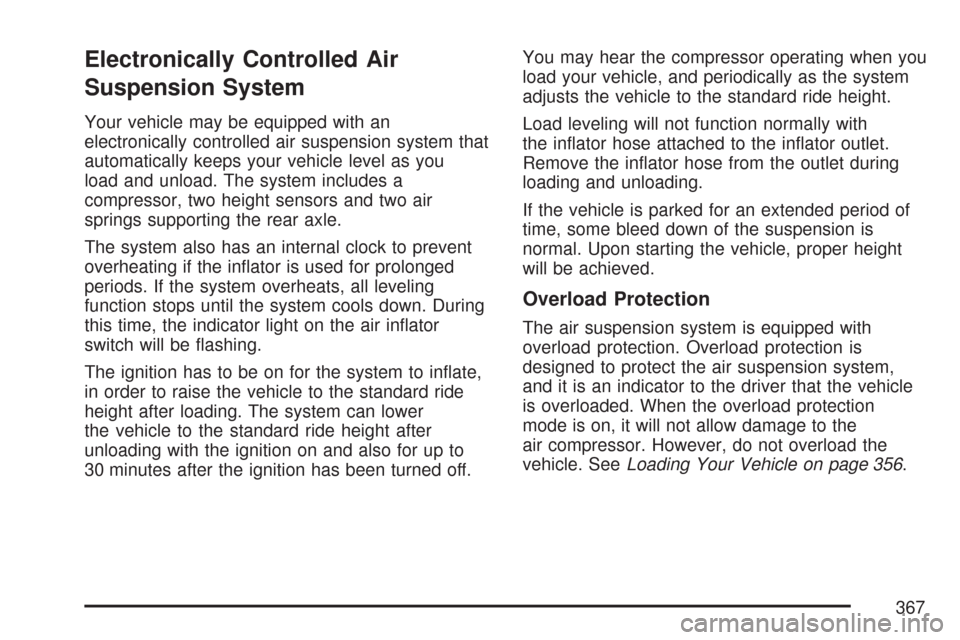
Electronically Controlled Air
Suspension System
Your vehicle may be equipped with an
electronically controlled air suspension system that
automatically keeps your vehicle level as you
load and unload. The system includes a
compressor, two height sensors and two air
springs supporting the rear axle.
The system also has an internal clock to prevent
overheating if the in�ator is used for prolonged
periods. If the system overheats, all leveling
function stops until the system cools down. During
this time, the indicator light on the air in�ator
switch will be �ashing.
The ignition has to be on for the system to in�ate,
in order to raise the vehicle to the standard ride
height after loading. The system can lower
the vehicle to the standard ride height after
unloading with the ignition on and also for up to
30 minutes after the ignition has been turned off.You may hear the compressor operating when you
load your vehicle, and periodically as the system
adjusts the vehicle to the standard ride height.
Load leveling will not function normally with
the in�ator hose attached to the in�ator outlet.
Remove the in�ator hose from the outlet during
loading and unloading.
If the vehicle is parked for an extended period of
time, some bleed down of the suspension is
normal. Upon starting the vehicle, proper height
will be achieved.
Overload Protection
The air suspension system is equipped with
overload protection. Overload protection is
designed to protect the air suspension system,
and it is an indicator to the driver that the vehicle
is overloaded. When the overload protection
mode is on, it will not allow damage to the
air compressor. However, do not overload the
vehicle. SeeLoading Your Vehicle on page 356.
367
Page 368 of 574
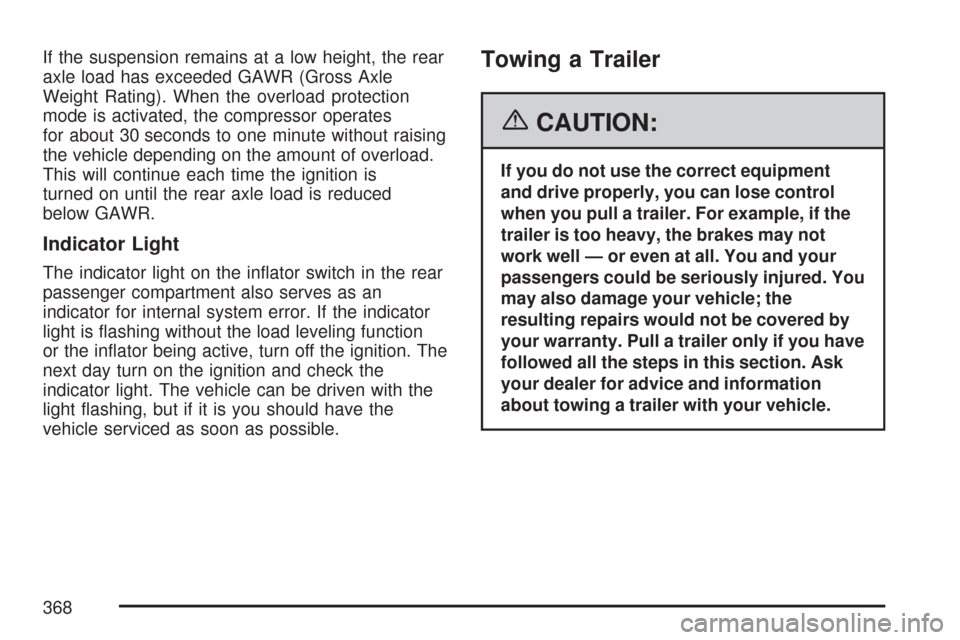
If the suspension remains at a low height, the rear
axle load has exceeded GAWR (Gross Axle
Weight Rating). When the overload protection
mode is activated, the compressor operates
for about 30 seconds to one minute without raising
the vehicle depending on the amount of overload.
This will continue each time the ignition is
turned on until the rear axle load is reduced
below GAWR.
Indicator Light
The indicator light on the in�ator switch in the rear
passenger compartment also serves as an
indicator for internal system error. If the indicator
light is �ashing without the load leveling function
or the in�ator being active, turn off the ignition. The
next day turn on the ignition and check the
indicator light. The vehicle can be driven with the
light �ashing, but if it is you should have the
vehicle serviced as soon as possible.
Towing a Trailer
{CAUTION:
If you do not use the correct equipment
and drive properly, you can lose control
when you pull a trailer. For example, if the
trailer is too heavy, the brakes may not
work well — or even at all. You and your
passengers could be seriously injured. You
may also damage your vehicle; the
resulting repairs would not be covered by
your warranty. Pull a trailer only if you have
followed all the steps in this section. Ask
your dealer for advice and information
about towing a trailer with your vehicle.
368
Page 409 of 574
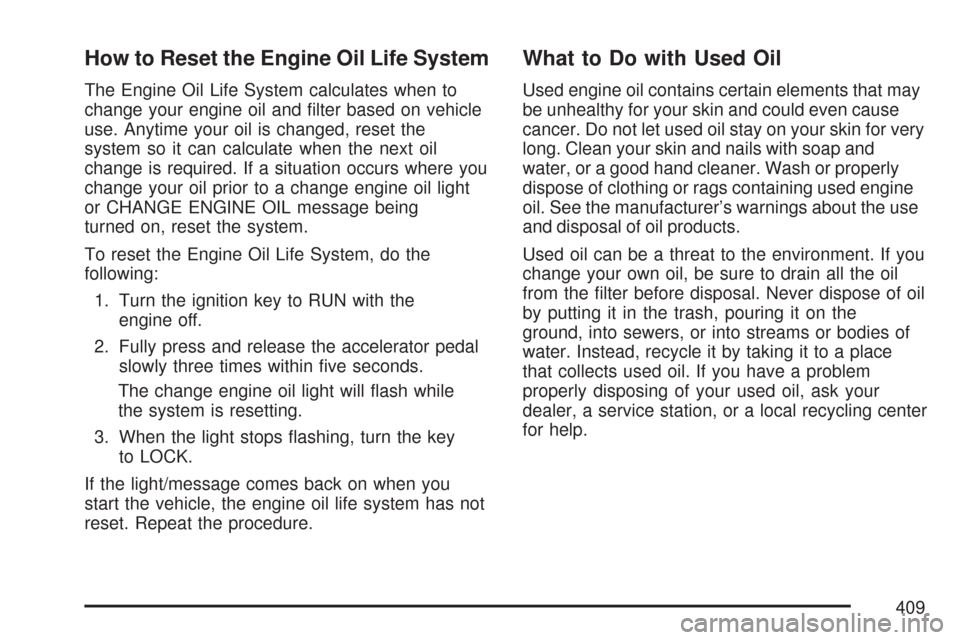
How to Reset the Engine Oil Life System
The Engine Oil Life System calculates when to
change your engine oil and �lter based on vehicle
use. Anytime your oil is changed, reset the
system so it can calculate when the next oil
change is required. If a situation occurs where you
change your oil prior to a change engine oil light
or CHANGE ENGINE OIL message being
turned on, reset the system.
To reset the Engine Oil Life System, do the
following:
1. Turn the ignition key to RUN with the
engine off.
2. Fully press and release the accelerator pedal
slowly three times within �ve seconds.
The change engine oil light will �ash while
the system is resetting.
3. When the light stops �ashing, turn the key
to LOCK.
If the light/message comes back on when you
start the vehicle, the engine oil life system has not
reset. Repeat the procedure.
What to Do with Used Oil
Used engine oil contains certain elements that may
be unhealthy for your skin and could even cause
cancer. Do not let used oil stay on your skin for very
long. Clean your skin and nails with soap and
water, or a good hand cleaner. Wash or properly
dispose of clothing or rags containing used engine
oil. See the manufacturer’s warnings about the use
and disposal of oil products.
Used oil can be a threat to the environment. If you
change your own oil, be sure to drain all the oil
from the �lter before disposal. Never dispose of oil
by putting it in the trash, pouring it on the
ground, into sewers, or into streams or bodies of
water. Instead, recycle it by taking it to a place
that collects used oil. If you have a problem
properly disposing of your used oil, ask your
dealer, a service station, or a local recycling center
for help.
409
Page 433 of 574

Notice:Ignoring these steps could result in
costly damage to your vehicle that would
not be covered by your warranty.
Trying to start your vehicle by pushing or
pulling it will not work, and it could damage
your vehicle.
1. Check the other vehicle. It must have a
12-volt battery with a negative ground system.
Notice:If the other vehicle’s system is not a
12-volt system with a negative ground,
both vehicles can be damaged. Only use
vehicles with 12-volt systems with negative
grounds to jump start your vehicle.
2. Get the vehicles close enough so the jumper
cables can reach, but be sure the vehicles are
not touching each other. If they are, it could
cause a ground connection you do not
want. You would not be able to start your
vehicle, and the bad grounding could damage
the electrical systems.To avoid the possibility of the vehicles rolling,
set the parking brake �rmly on both vehicles
involved in the jump start procedure. Put an
automatic transmission in PARK (P) or a
manual transmission in NEUTRAL before
setting the parking brake. If you have a
four-wheel-drive vehicle, be sure the transfer
case is not in NEUTRAL.
Notice:If you leave your radio or other
accessories on during the jump starting
procedure, they could be damaged. The repairs
would not be covered by your warranty.
Always turn off your radio and other
accessories when jump starting your vehicle.
3. Turn off the ignition on both vehicles.
Unplug unnecessary accessories plugged into
the cigarette lighter or the accessory power
outlets, if equipped. Turn off the radio and all
lamps that are not needed. This will avoid
sparks and help to save both batteries. And it
could save the radio!
433
Page 460 of 574
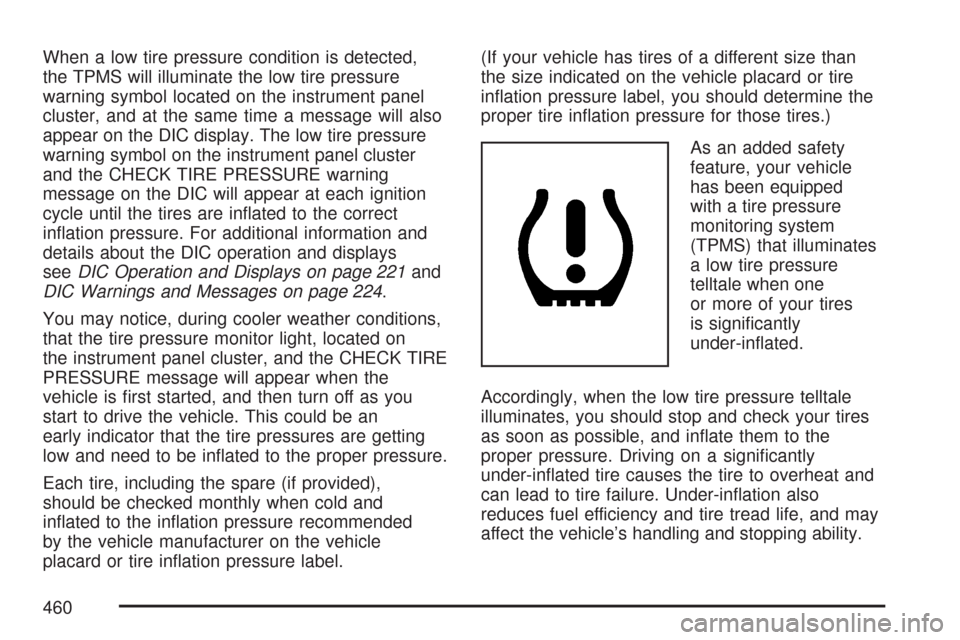
When a low tire pressure condition is detected,
the TPMS will illuminate the low tire pressure
warning symbol located on the instrument panel
cluster, and at the same time a message will also
appear on the DIC display. The low tire pressure
warning symbol on the instrument panel cluster
and the CHECK TIRE PRESSURE warning
message on the DIC will appear at each ignition
cycle until the tires are in�ated to the correct
in�ation pressure. For additional information and
details about the DIC operation and displays
seeDIC Operation and Displays on page 221and
DIC Warnings and Messages on page 224.
You may notice, during cooler weather conditions,
that the tire pressure monitor light, located on
the instrument panel cluster, and the CHECK TIRE
PRESSURE message will appear when the
vehicle is �rst started, and then turn off as you
start to drive the vehicle. This could be an
early indicator that the tire pressures are getting
low and need to be in�ated to the proper pressure.
Each tire, including the spare (if provided),
should be checked monthly when cold and
in�ated to the in�ation pressure recommended
by the vehicle manufacturer on the vehicle
placard or tire in�ation pressure label.(If your vehicle has tires of a different size than
the size indicated on the vehicle placard or tire
in�ation pressure label, you should determine the
proper tire in�ation pressure for those tires.)
As an added safety
feature, your vehicle
has been equipped
with a tire pressure
monitoring system
(TPMS) that illuminates
a low tire pressure
telltale when one
or more of your tires
is signi�cantly
under-in�ated.
Accordingly, when the low tire pressure telltale
illuminates, you should stop and check your tires
as soon as possible, and in�ate them to the
proper pressure. Driving on a signi�cantly
under-in�ated tire causes the tire to overheat and
can lead to tire failure. Under-in�ation also
reduces fuel efficiency and tire tread life, and may
affect the vehicle’s handling and stopping ability.
460
Page 462 of 574

TPMS Sensor Identi�cation Codes
Each TPMS sensor has a unique identi�cation
code. Any time you replace one or more of
the TPMS sensors or rotate the vehicle’s tires,
the identi�cation codes will need to be matched to
the new tire/wheel position. The sensors are
matched to the tire/wheel positions in the following
order: driver’s side front tire, passenger’s side
front tire, passenger’s side rear tire, and driver’s
side rear tire using a TPMS diagnostic tool.
See your dealer for service.
The TPMS sensors may also be matched to each
tire/wheel position by increasing or decreasing
the tire’s air pressure. When increasing the tire’s
pressure, do not exceed the maximum in�ation
pressure indicated on the tire’s sidewall.You will have two minutes to match the �rst
tire/wheel position, and �ve minutes overall to
match all four tire/wheel positions. If it takes longer
than two minutes, to match the �rst tire and wheel,
or more than �ve minutes to match all four tire
and wheel positions the matching process
stops and you will need to start over.
The TPMS sensor matching process is
outlined below:
1. Set the parking brake.
2. Turn the ignition switch to RUN with the
engine off.
3. Turn the headlamp control from off to parking
lamps four times within three seconds.
A double horn chirp will sound and the TPMS
low tire warning light will begin to �ash.
The double horn chirp and �ashing TPMS
warning light indicate that the TPMS matching
process has started. The TPMS warning
light should continue �ashing throughout the
matching procedure.
462
Page 463 of 574
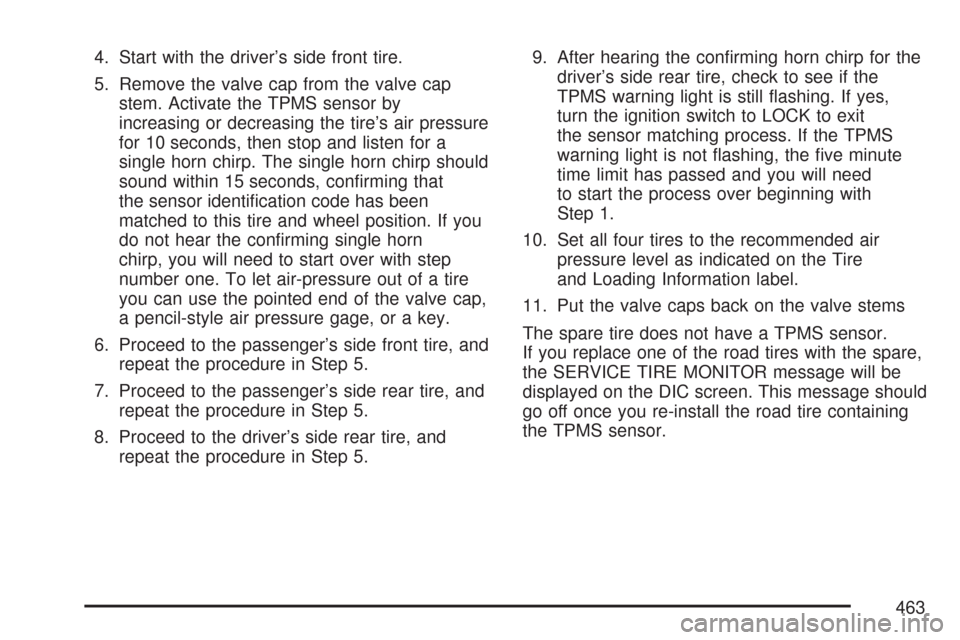
4. Start with the driver’s side front tire.
5. Remove the valve cap from the valve cap
stem. Activate the TPMS sensor by
increasing or decreasing the tire’s air pressure
for 10 seconds, then stop and listen for a
single horn chirp. The single horn chirp should
sound within 15 seconds, con�rming that
the sensor identi�cation code has been
matched to this tire and wheel position. If you
do not hear the con�rming single horn
chirp, you will need to start over with step
number one. To let air-pressure out of a tire
you can use the pointed end of the valve cap,
a pencil-style air pressure gage, or a key.
6. Proceed to the passenger’s side front tire, and
repeat the procedure in Step 5.
7. Proceed to the passenger’s side rear tire, and
repeat the procedure in Step 5.
8. Proceed to the driver’s side rear tire, and
repeat the procedure in Step 5.9. After hearing the con�rming horn chirp for the
driver’s side rear tire, check to see if the
TPMS warning light is still �ashing. If yes,
turn the ignition switch to LOCK to exit
the sensor matching process. If the TPMS
warning light is not �ashing, the �ve minute
time limit has passed and you will need
to start the process over beginning with
Step 1.
10. Set all four tires to the recommended air
pressure level as indicated on the Tire
and Loading Information label.
11. Put the valve caps back on the valve stems
The spare tire does not have a TPMS sensor.
If you replace one of the road tires with the spare,
the SERVICE TIRE MONITOR message will be
displayed on the DIC screen. This message should
go off once you re-install the road tire containing
the TPMS sensor.
463